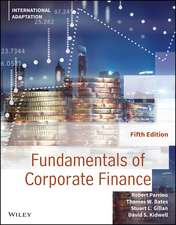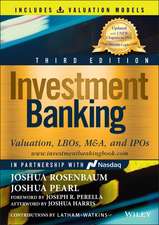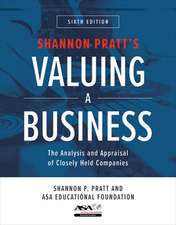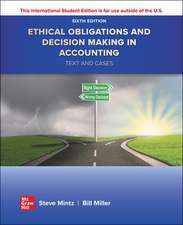Survival Kit for an Equity Analyst: The Essentials You Must Know
Autor S Horieen Limba Engleză Hardback – 27 oct 2021
- A robust background on the basic process flow of company analysis and valuation
- Guidelines for examining earnings drivers in major industries
- Tips on the qualitative profiling of companies and how to dig deeper to find nuance that financial statements don't express
Preț: 226.52 lei
Nou
Puncte Express: 340
Preț estimativ în valută:
43.35€ • 47.07$ • 36.41£
43.35€ • 47.07$ • 36.41£
Carte tipărită la comandă
Livrare economică 22 aprilie-06 mai
Livrare express 15-21 martie pentru 42.16 lei
Preluare comenzi: 021 569.72.76
Specificații
ISBN-13: 9781119822448
ISBN-10: 1119822440
Pagini: 208
Dimensiuni: 163 x 235 x 21 mm
Greutate: 0.48 kg
Editura: Wiley
Locul publicării:Chichester, United Kingdom
ISBN-10: 1119822440
Pagini: 208
Dimensiuni: 163 x 235 x 21 mm
Greutate: 0.48 kg
Editura: Wiley
Locul publicării:Chichester, United Kingdom
Cuprins
Preface: Why I Wanted to Write This Book xi
Introduction: How to Approach Company Analysis xv
List of Acronyms xix
Part I: Lessons From the Past: My Story as an Analyst 1
From Fish Cakes to Computer Numerical Control (1988-1995) 2
Not Just a Japanese Tourist - Becoming a China H-share Analyst (1996-1998) 5
A Truly Global Research Experience - Semiconductor Analyst (1998-2007) 7
New Lexicon: Clinical Trial, Cap Rate, Embedded Value, Metal Spread (2008-2013) 11
Importing DM Experience to EM: From Japan to Asia-Pacific (2014-2017) 13
Connecting the Dots: From Asia to Global (2018-now) 16
Part II: Laying the Groundwork 19
Chapter 1: Understand the 'Character' of the Industry 21
Six Basic Steps for Forecasting Industry Growth 22
TAM Growth Rate 27
Ten Additional Angles for Testing Forecasts 28
Chapter 2: Assess the Earnings Drivers in Different Industries 37
Hyper Growth - Internet, Fintech, Biotechnology 45
Secular Growth - Software, Medical Technology 48
Cyclical - Capital Goods, Transport, Energy,
Commodities, Chemicals, Autos 49
Cyclical Growth - Semiconductor, Electronic Components, Technology Hardware, Clean Energy 54
Stable - Consumer Staples, Retail, Consumer Discretionary, Pharmaceutical, Media, Business Services 58
Interest Rate Sensitive - REITs, Property Developers, Banks, Insurance 63
Regulated - Utilities, Telecoms 66
Chapter 3: Identify the 'Personality' of the Company 71
Product and Service 71
Origin and History 72
Management Profile 73
Ownership Structure 73
Value Chain 74
Competitive Moat 75
Track Record of Strategic Decisions 76
Corporate Culture by Country 77
Earnings Guidance Track Record 77
Controversy Record 78
Management Quality - A Framework 78
Part III: Analyse and Apply the Findings 83
Chapter 4: Put Findings into the Earnings Model 85
Segmental Revenue Forecast 87
Income Statement Forecast 88
Balance Sheet Forecast 95
Cash Flow Forecast 98
How to Put Cyclicality into Long-term Earnings Forecasts 100
Quarterly Forecasts can be Helpful 100
A Birdseye View is Helpful 101
Financial and Property Sectors are Unique 101
Chapter 5: Summarize All Thoughts 105
A Suggested Method for Creating a Practical Scorecard 105
Chapter 6: Find the Appropriate Valuation Framework 109
Hyper Growth - Internet, Biotechnology 112
Secular Growth - Software, Medical Technology 114
Cyclical - Capital Goods, Transport, Energy,
Commodities, Chemicals, Autos 115
Cyclical Growth - Semiconductor, Technology Hardware, Clean Energy 116
Stable - Consumer Staples, Retail, Consumer Discretionary, Pharmaceutical, Media, Business Services 117
Interest Rate Sensitive - Banks, Emerging Market Banks, Insurance, Property, REITs 118
Regulated - Utilities, Telecoms 120
Conglomerates 121
Additional Considerations on Valuation 124
Chapter 7: Differentiation versus Street 131
Is the View Actually Different? 131
Where is the Difference? 132
What is Driving the Difference? 133
Value of an Undifferentiated Conclusion 134
Part IV: What to Research and How to Power the Analysis 135
Chapter 8: How to Generate Exciting Ideas 137
1: Burning Questions 137
2: Products to Solve Problems 138
3: Forgotten New Technologies 138
4: 'Little Stories' 139
5: New Language 140
6: B2B and Orphan Stocks 140
7: The Second or Third Derivatives of Structural Changes 141
8: Local Trends 141
9: Inputs from the Real World 141
Chapter 9: How to Deal with Disruptors, Emerging Markets, ESG, and Downturns 145
How to Forecast and Value 'Disruptors' 145
How Should Emerging Markets be Looked at? 149
How to Think about ESG Issues 151
How to Cope with Economic Downturns 155
Chapter 10: Using Soft Skills to Power the Analysis 157
How to Build a Relationship with Companies 157
How to Leverage the Team 159
How to Communicate Ideas Effectively 161
What Types of Training Should New Analysts Ask for? 163
Time Management 165
Part V: Recap and Closing Thoughts 169
About the Author 173
Acknowledgements 175
Index 177
Notă biografică
SHIN HORIE is cohead of Global Single-Name Research (Equity and Credit Research) for Goldman Sachs and is a board member of Goldman Sachs Asia LLC. He is the former director of the Japan Equity Research Department and the former manager of the Korea and Taiwan Equity Research Departments.





















